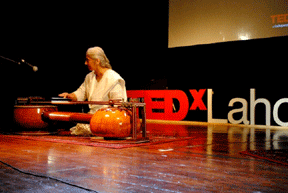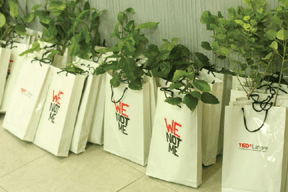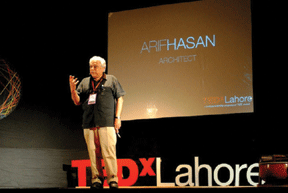On a warm afternoon interspersed by gracious drizzles, TEDx Lahore 2010 took place at the Ali Auditorium on Ferozepur Road; an excellent choice for the venue?s lush green gardens and adequate spacing if we ignore the miniscule lobby near the entrance that had throngs of people squashed inside and fanning themselves with pamphlets, waiting for the hall to open.
I could see that the crowd was a good mix of upper elite and middle socioeconomic strata. There were fashionably dressed activists clutching their tech gadgets, bearded students from private universities and cute looking aunties and uncles waiting for their turn to be seated. The organizers said there were more than a 1000 applications for 380 seats and to include all of those who couldn?t attend, there were 4 live viewing parties in Lahore, Karachi and even the Pakistani embassy in Holland.
The theme of the talk this year was ‘Collective Genius’ and featured fifteen speakers and two musical performances.
From among the ones who truly fitted the theme of the day and presented ‘ideas worth spreading’, digital Cartographers; Omar Sheikh and Jabran Rafique spoke about the challenges they faced in mapping the areas of Attabad devastated by landslides. They combined their effort with NGOs (Hunza Landslide Monitoring, Propakistani); companies like Telenor together with collaboration from NASA and a resident of the sunk villages, producing a portal for viewers around the world to see and help with real time relief work.
The star of the evening was Zeeshan ul Haq Usmani;
a Fullbright Scholar currently teaching at the GIK University Islamabad. With his animated speech laced with humour, Zeeshan showed the simulation model that he has painstakingly created to show the effects of suicide bomb blasts. The work made Zeeshan go through heaps of forensic records stored on paper in various hospitals and he has studied the area so minutely that he can now look at victim injuries and tell which terrorist organization was involved in the act. His simulation model can help in preventive safety measures, forensic investigation and give details of how many medical experts and drugs a particular bombing site requires instantly.
Zeeshan made the macabre discussion so funny that the audience was in stitches with his one liners like, ‘let me put more ladies into the (bombing simulation model?s) crowd to give them equal opportunity’ and ‘with the database we have, we can give consultancies to the entire world’ . He got a standing ovation and a resounding applause long after he was gone.
Zubair Bhatti, the ex DCO of Jhang and now a Director at the Asia Foundation, spoke of his simple corruption busting model that uses cell phones. The model was successfully implemented in Jhang where government officials called up ordinary citizens after they had transacted with a government functionary and asked them if they had to pay any bribes to get their work done. According to Zubair, the phone calls led to a 90% decrease in the incidence of corruption and the model is now being implemented all over Punjab.
Mudassir Zia, a young engineer, spoke of how 5 of his friends wanted to do ‘something’ for the country and started teaching the children of their domestic staff.
Having grown in small increments, today they run a school that provides free education to 150 students from impoverished homes. They also manage the Message Blood Donor Society, and a Kafalat program for helping the needy irrespective of their religious beliefs. Mudassir’s group does not borrow money from anyone, they instead collect animal hides during Eid ul Azha and sell them besides also collecting and selling solid waste from neighborhoods to generate funds. A quote from his presentation was particularly moving as it said ‘The only helping hand is at the end of your arm’. Though what Mudassir spoke of was nothing phenomenal or incredible, his speech resonated with passion and nudged the audience into thinking what they could do, within their own, immediate spheres of influence.
There was Aamir Khan from the Interactive Research Designs, who, with his small team of techies, has created wonderful solutions for healthcare in Pakistan using cellular technology. His objective has been to gather reliable data from the field and provide it to medical experts for intervention using the cheapest possible means. From HIV incidence to pneumonia tracking, he has covered major areas that have been ignored by bringing them onto Google maps and connecting them to hospital data provided through the mobile phone. So, a doctor can click on the Korangi, Karachi Google map and click on a particular household to see the medical status of a child suffering from pneumonia. Aamir?s work has won him laurels around the world and his software model is on display this year at the Smithsonian Institute, USA. He has also been invited to present his work at the UN Summit for First Ladies.
Dr Asher Hasan spoke of ending the socioeconomic apartheid in Pakistan by using the collective genius of children to design the first child-to-child microfinance program in the world that could enable wealthy children to support the poor ones.
There were other speakers who gave insightful talks though they weren?t as passionate and inspiring as the ones above. Architect Arif Hasan spoke of changing urban and sociological trends in Pakistan and the gaps they are producing, Dr Tariq Rehman; a sociolinguist, described the emerging trend of Urdu speech being mixed up with English and Hindi and said it was not an alarming issue since code switching is the sign of a living language. Saima Raza; a communication design expert, showed a colourful presentation of how the visual art in Pakistan carries a fusion of multiple cultures.
There were other talks that failed to engage the audience, yet the overpowering feel of the evening was that of hope, optimism, energy and fun. There were wonderful surprises for the participants too. A jamming session at the end by four percussionists and free tree saplings for everyone to plant were a hit. The team of organizers arranged for 380 saplings from the Pakistan Agricultural Research Centre, belonging to 25 different species of tree, to be given away to everyone to help the environment and to remind them of the event for years and years to come.

Noor Zehra stole the show with her brilliant Saagar Veena performance - Photo Credit: Kashif Altaf/ TEDx Lahore
There was also an excellent musical performance by Noor Zehra Kazim on the Veena Sagar; the only instrument of its kind in the world that has been created by her father Raza Kazim in Pakistan and can play the highest variation of notes for a stringed instrument.
Despite the little glitches in the scheduling and lighting, the young team of organizers must be given credit for pulling off the event so successfully. TEDx Lahore 2010 was about ideas worth spreading!








